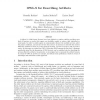197 search results - page 13 / 40 » Representing Phenotypes in OWL |
EUMAS
2006
13 years 9 months ago
2006
Artifacts for Multi-Agent Systems have been defined as runtime entities providing some kind of function or service that agents can fruitfully exploit to achieve their individual o...
JBCS
2010
13 years 2 months ago
2010
Schema matching is a fundamental issue to many database applications, such as query mediation and data warehousing. It becomes a challenge when different vocabularies are used to r...
SEMWEB
2009
Springer
14 years 2 months ago
2009
Springer
Abstract. Most Semantic Web applications are build on top of technology based on the Semantic Web layer cake and the W3C ontology languages RDF(S) and OWL. However RDF(S) embodies ...
BMCBI
2007
13 years 7 months ago
2007
The bio-ontology community falls into two camps: first we have biology domain experts, who actually hold the knowledge we wish to capture in ontologies; second, we have ontology s...
GECCO
2004
Springer
14 years 1 months ago
2004
Springer
Extending the notion of inheritable genotype in genetic programming (GP) from the common model of DNA into chromatin (DNA and histones), we propose an approach of embedding in GP a...

